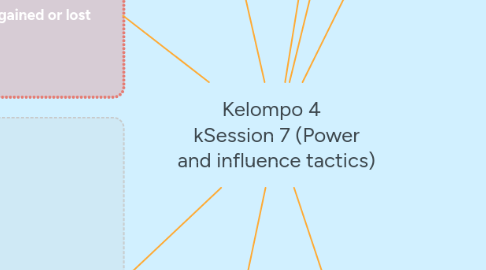
1. Power and influence concept
1.1. Power
1.2. Authority
1.3. Influence procces
1.3.1. Instrumental compliance
1.3.2. Internationalization
1.3.3. Personal identification
2. General tyoe of influence tactics
2.1. Impression manamgement tactics
2.2. Political tactics
2.3. Pro active tactics
2.4. Influence outcomes
2.4.1. Commitment
2.4.2. Compliance
2.4.3. Resistence
3. Power sources
3.1. Position power
3.1.1. Legitimate power
3.1.2. Reward power
3.1.3. coercive power
3.1.4. information power
3.1.5. Ecological power
3.2. Personal power
3.2.1. Referent power
3.2.1.1. Ways to gain and use referent power
3.2.1.1.1. Show acceptance and positive regard
3.2.1.1.2. be supportive and helpful
3.2.1.1.3. use sincere forms or ingratition
3.2.1.1.4. keep promises and commitment
3.2.1.1.5. make self sacrifes to benefit other
3.2.1.1.6. lead by example(use role modeling)
3.2.1.1.7. Explain the personal importance
3.2.2. Expert power
3.2.2.1. Ways to use and maintain expert power
3.2.2.1.1. Explain the reason for a request or proposal and why it is important
3.2.2.1.2. Provide evidence that a proposal will be succesful
3.2.2.1.3. Listen seriously to the person concerns and suggestions
3.2.2.1.4. act confident and decisive in a crisis
3.2.2.1.5. Dont lie,exaggrete,or mispresent the facts
3.2.2.1.6. Dont make rash,Careless,or inconsistent statement'
4. How power is gained or lost
4.1. Social exchange theory
4.2. strategic contingencies theory
4.3. Institutionalization of power
5. Legitimate authority
5.1. Make polite,clear request
5.2. Explain the reason for a request
5.3. Dont exceed your scope of authority
5.4. Verify authority it necessary
5.5. follow proper channels
5.6. follow up verify compliance
5.7. Instint on compliance if appropiate
6. Reward Power
6.1. offer the type of rewards that people desire
6.2. offer the rewards that are fair and ethcical
6.3. explain the criteria for giving rewards and keep it simple
6.4. use rewards symbolically(Not in manipulative way
6.5. Dont promise more than you can deliver
7. Discipline
7.1. 1.explain rules and requirements,and ensure that people understand the serious consequences of violiotins
7.2. 2.Respond to infractions promptly and consistenly without showing any favoritsm to particular individual
7.3. 3.Investigate to get the facts before using reprimands or punishment,and aoid jumping to conclusion or making hasty accusations
7.4. 4. Except for the most serious infaction,provide sufficient oral and written warnings before resorting to punishment
7.5. 5.administer warnings and reprimand in private,and avoid making rash threats
7.6. 6.stay calm and avoid the appereance of hostility or personal rejection
7.7. 7. express a sincere desire to help the person comply with role expectations and thereby avoid punishment
7.8. 8. invite the person to suggest ways to correct the problem, and seek agremeent on a concrete plan
7.9. 9.maintan credibility by administering punishment if non compliance continues after threats and warnings have been made
7.10. 10. use punishment that are legitimate,fair,and commensurate with the seriousness of the infraction
8. Core tactics
8.1. Rational persuassion
8.1.1. Explain in detail why a request or proposal is important
8.1.2. Use facts and logic to make a clear case in support of a request or proposal
8.1.3. Provide evidence that a request or proposal is feasible
8.1.4. explain why a proposal is better than alternatives
8.2. Inspirational appeals
8.2.1. Describe a proposed change as an exiting and worthwile oppurtinity
8.2.2. Describe a clear,appealing vision of what cant be accomplished by a project or change
8.2.3. Use a dramatic,Expressive style of speaking and positive,optimistic languange
8.2.4. Link a proposed activity or change to the person ideal and values
8.3. Consultation
8.3.1. State your objective,and ask what he person can do to help attain it
8.3.2. ask for suggestions on how to improve a tentative proposal
8.3.3. Involve the person in planning action steps to attain an objective
8.3.4. Respond in a positive way to any concerns expressed by the person
8.4. Collaboration
8.4.1. Offer to show the person how to perfrm a requested task
8.4.2. Offer to provide neccesary resources
8.4.3. Offer to help the person solve problems caused by a request
8.4.4. Offer to help the person implement a proposed change

